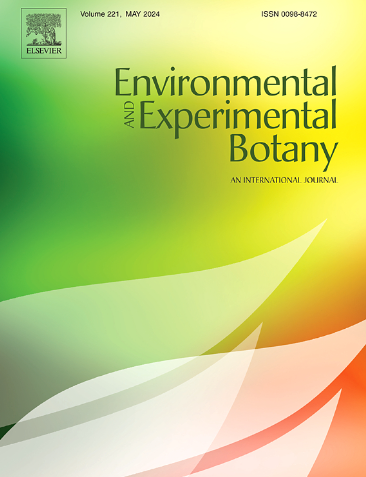Hydrogen sulfide enhances salt tolerance in tomato by regulating cell wall degradation in a SlSR3-dependent manner
IF 4.7
2区 生物学
Q2 ENVIRONMENTAL SCIENCES
引用次数: 0
Abstract
Soil salinization is an important abiotic stress that limits the productivity and quality of horticultural crops. As critical signaling molecules, hydrogen sulfide (H2S) and calcium ions (Ca2 +) are crucial in plant stress reponse. However, the molecular basis of their synergistic action in improving salt tolerance in plants is unclear. In this study, tomato (Solanum lycopersicum L.) seedlings were utilized as a material to explore the synergistic effect of H2S and Ca2+ on salt stress tolerance. The results show that exogenous sodium hydrosulfide (NaHS, a H2S donor) and CaCl2 independently ameliorated the inhibitory effects of salt stress on tomato seedling growth, with their co-application demonstrating a synergistic alleviation of stress-induced growth impairment. Further studies reveal that H2S promoted Ca2+ level and up-regulated signal-responsive 3 (SR3) expression. SlSR3 knockout mutants were more sensitive to salt stress, whereas overexpression of SlSR3 displayed enhanced salt tolerance. Moreover, SlSR3 conferred protection against salt stress-induced cell wall degradation and sustained its stability by repressing the expression of genes implicated in cell wall degradation. Further results demonstrate that NaHS treatment did not enhance cell wall integrity or salt tolerance in SlSR3 knockout mutants. Conversely, NaHS treatment effectively inhibited cell wall degradation and improved salt tolerance in SlSR3-overexpressing plants. Therefore, SlSR3 is likely implicated in the H2S-mediated inhibition of cell wall degradation in tomato seedlings under salt stress, ultimately enhancing salt tolerance. This study delineates the mechanistic interplay between H2S and Ca2+ in plant salt tolerance, thereby enhancing the potential for breeding horticultural crops with improved stress resilience.
硫化氢以slsr3依赖的方式调节细胞壁降解,从而增强番茄的耐盐性
土壤盐渍化是制约园艺作物产量和品质的重要非生物胁迫。作为重要的信号分子,硫化氢(H2S)和钙离子(Ca2 +)在植物的逆境响应中起着至关重要的作用。然而,它们在提高植物耐盐性方面协同作用的分子基础尚不清楚。本研究以番茄(Solanum lycopersicum L.)幼苗为材料,探讨H2S和Ca2+对盐胁迫耐受性的协同效应。结果表明,外源氢硫化钠(NaHS, H2S供体)和CaCl2单独改善了盐胁迫对番茄幼苗生长的抑制作用,它们的共同施用显示出协同缓解胁迫诱导的生长损伤。进一步研究发现H2S促进Ca2+水平,上调SR3 (signal responsive 3)表达。SlSR3敲除突变体对盐胁迫更敏感,而过表达SlSR3的突变体对盐的耐受性增强。此外,SlSR3对盐胁迫诱导的细胞壁降解具有保护作用,并通过抑制与细胞壁降解相关的基因表达来维持其稳定性。进一步的结果表明,NaHS处理并没有提高SlSR3敲除突变体的细胞壁完整性或耐盐性。相反,NaHS处理能有效抑制slsr3过表达植物细胞壁降解,提高其耐盐性。因此,SlSR3可能参与h2s介导的盐胁迫下番茄幼苗细胞壁降解的抑制,最终增强耐盐性。本研究揭示了H2S和Ca2+在植物耐盐性中的相互作用机制,从而提高了培育具有抗逆性的园艺作物的潜力。
本文章由计算机程序翻译,如有差异,请以英文原文为准。
求助全文
约1分钟内获得全文
求助全文
来源期刊

Environmental and Experimental Botany
环境科学-环境科学
CiteScore
9.30
自引率
5.30%
发文量
342
审稿时长
26 days
期刊介绍:
Environmental and Experimental Botany (EEB) publishes research papers on the physical, chemical, biological, molecular mechanisms and processes involved in the responses of plants to their environment.
In addition to research papers, the journal includes review articles. Submission is in agreement with the Editors-in-Chief.
The Journal also publishes special issues which are built by invited guest editors and are related to the main themes of EEB.
The areas covered by the Journal include:
(1) Responses of plants to heavy metals and pollutants
(2) Plant/water interactions (salinity, drought, flooding)
(3) Responses of plants to radiations ranging from UV-B to infrared
(4) Plant/atmosphere relations (ozone, CO2 , temperature)
(5) Global change impacts on plant ecophysiology
(6) Biotic interactions involving environmental factors.
 求助内容:
求助内容: 应助结果提醒方式:
应助结果提醒方式:


